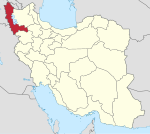Churs
Churs
Persian: چورس | |
|---|---|
Village | |
| Coordinates: 38°49′45″N 45°02′05″E / 38.82917°N 45.03472°E[1] | |
| Country | Iran |
| Province | West Azerbaijan |
| County | Chaypareh |
| District | Central |
| Rural District | Churs |
| Population (2016)[2] | |
| • Total | 2,081 |
| Time zone | UTC+3:30 (IRST) |
Churs (Persian: چورس; in Armenian: Ճուաշ or Չորս), also Romanized as Chūrs, Chowras, and Chowrs; also known as Choras, Chors, and Jūres,[3] is a village in, and the capital of, Churs Rural District[4] of the Central District of Chaypareh County, West Azerbaijan province, Iran.
At the 2006 National Census, its population was 2,367 in 636 households, when it was in the former Chaypareh District of Khoy County.[5] The following census in 2011 counted 2,430 people in 733 households,[6] by which time the district had been separated from the county in the establishment of Chaypareh County.[7] The latest census in 2016 showed a population of 2,081 people in 660 households. It was the most populous village in its rural district.[2]
The location of modern-day Churs proved to be extremely pivotal in Armenian history. On 26 May 451 AD, a decisive battle was fought at the location that would be one of the single most important events in Armenian history. On the Avarayr Plain, at what is modern-day Churs in the West Azerbaijan Province, the Armenian Army under Vardan Mamikonian clashed with Sassanid Persia. Although the Persians were victorious on the battlefield itself, the battle proved to be a major strategic victory for Armenians, as Avarayr paved the way to the Nvarsak Treaty (484 AD), which affirmed Armenia's right to practice Christianity freely.[8][9]
References[edit]
- ^ OpenStreetMap contributors (16 February 2024). "Churs, Chaypareh County" (Map). OpenStreetMap. Retrieved 16 February 2024.
- ^ a b "Census of the Islamic Republic of Iran, 1395 (2016)". AMAR (in Persian). The Statistical Center of Iran. p. 04. Archived from the original (Excel) on 30 August 2022. Retrieved 19 December 2022.
- ^ Churs can be found at GEOnet Names Server, at this link, by opening the Advanced Search box, entering "-3058837" in the "Unique Feature Id" form, and clicking on "Search Database".
- ^ Mousavi, Mirhossein (2 February 1366). "Creation and formation of 12 rural districts including villages, farms and places located in Khoy County of West Azerbaijan province". Islamic Parliament Research Center (in Persian). Ministry of Interior, Board of Ministers. Archived from the original on 4 August 2014. Retrieved 23 December 2023.
- ^ "Census of the Islamic Republic of Iran, 1385 (2006)". AMAR (in Persian). The Statistical Center of Iran. p. 04. Archived from the original (Excel) on 20 September 2011. Retrieved 25 September 2022.
- ^ "Census of the Islamic Republic of Iran, 1390 (2011)". Syracuse University (in Persian). The Statistical Center of Iran. p. 04. Archived from the original (Excel) on 20 January 2023. Retrieved 19 December 2022.
- ^ Davodi, Parviz (18 September 1386). "Approval letter regarding reforms of country divisions in West Azerbaijan province". Islamic Parliament Research Center (in Persian). Ministry of Interior, Political-Defense Commmission. Archived from the original on 13 April 2014. Retrieved 21 November 2023.
- ^ Hewsen, Robert H. (17 August 2011). "AVARAYR". Encyclopædia Iranica.
So spirited was the Armenian defense, however, that the Persians suffered enormous losses as well. Their victory was pyrrhic and the king, faced with troubles elsewhere, was forced, at least for the time being, to allow the Armenians to worship as they chose.
- ^ Susan Paul Pattie (1997). Faith in History: Armenians Rebuilding Community. Smithsonian Institution Press. p. 40. ISBN 1560986298.
The Armenian defeat in the Battle of Avarayr in 451 proved a pyrrhic victory for the Persians. Though the Armenians lost their commander, Vartan Mamikonian, and most of their soldiers, Persian losses were proportionately heavy, and Armenia was allowed to remain Christian.


